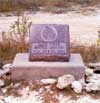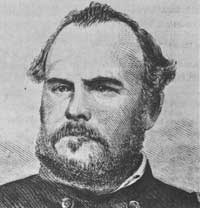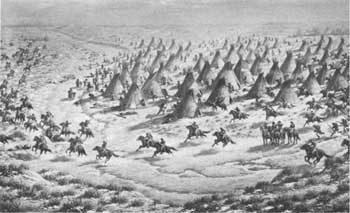





Survey of Historic Sites and Buildings
 |
SAND CREEK MASSACRE NATIONAL HISTORIC SITE Colorado |
 |
| ||
 |
| Coloradans applauded and Congress denounced Col. John M. Chivington ("The Fighting Parson") for the butchery at Sand Creek. Portrait from Frank Leslie's Illustrated Newspaper (December 19, 1863). (Denver Public Library, Western Collection) |
At this site occurred the tragic Sand Creek, or Chivington, Massacre, one of the results of the Indian-white conflict that boiled in Colorado during the Civil War. The Southern Cheyennes and Arapahos, resenting the mounting invasion of settlers and miners and taking advantage of the absence of Regular troops, took to the warpath. Both Indians and whites committed savage killings. By the spring of 1864 Coloradans were screaming for revenge. As a prelude to military action, that summer Territorial officials extended vague promises of sanctuary to Indian groups reporting to Army forts. One of those that did so, at Fort Lyon, Colo., in October, was led by Black Kettle. Believing themselves to be under the protection of the fort, he and about 500 Cheyennes and a handful of Arapahos camped at Sand Creek, 40 miles down the Arkansas River.
On November 29 Col. John M. Chivington, a strong advocate of Indian extermination, and 700 Colorado Volunteers appeared at the camp without warning, following a march through bitter cold and snow from Fort Lyon. Although Black Kettle hastily raised the U.S. and white flags to confirm his peaceful intent, the troops swooped down on his poorly armed people and indiscriminately killed and mutilated 200 of them, nearly two-thirds women and children, though Black Kettle managed to escape. Most Denverites approved of Chivington's actions, but a congressional investigation denounced him for the wanton slaughter and he resigned. The word of the massacre spread swiftly among the Plains Indians. By the following summer practically all the tribes between Canada and the Red River were at war, and the weak Army garrisons were forced to stand by impotently.
 |
| Robert Lindneux's version of the Sand Creek Massacre. (Colorado Historical Society) |
The natural features of the site, privately owned rangeland, have not changed essentially since 1864. A stone marker is located on a ridge overlooking the bottomland where Black Kettle's village stood. Designated Sand Creek Massacre National Historic Site in 2000, it is authorized, but will not be established until the NPS acquires enough land to provide for the preservation,commemoration, and interpretation of the Sand Creek Massacre. While the NPS has acquired 920 acres within the authorized boundary, the remainder of the land is under private and state ownership. Until enough land has been acquired to establish the National Historic Site, it will not be open to the public.
 |
 |
http://www.cr.nps.gov/history/online_books/soldier-brave/sitea10.htm
Last Updated: 19-Aug-2005